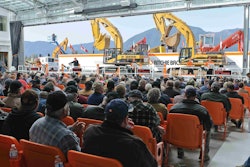Double or triple the life of your tires for a fraction of the price of new
By Tom Jackson
In most things, pinching pennies means some sacrifice in quality. But when you retread a tire you get equal or better the performance, warranty and longevity of a new tire for 30 to 50 percent of the cost of new.
 High tech equipment and trained technicians are part of any good retreading operation today.
High tech equipment and trained technicians are part of any good retreading operation today.
If you’re not retreading your tires, you’re probably in the minority. Roughly half the commercial truck tires you see on the road today are retreads, says Chris Hoffman, manager truck and bus radial and retread marketing for Bridgestone Firestone. Retreading rates for off-road tires are similar.
“Even if a customer isn’t retreading, he should be selling his casings and retrieving some of that core value,” says Norm Ball, training officer at Michelin Retread Technologies. “Retreaders in the United States import between 3 and 4 million used casings every year to fill the need for retreaded tires, he says. “Fifty percent of the retreads in this country are not on the customer’s casing.”
Maintenance first
The key to successfully retreading your own casings is to keep your new tires properly inflated and pull them before the tread gets too thin.
 Thanks to better materials and techniques punctures and cuts that used to cause a casing to be rejected can today be repaired and overlaid with a retread.
Thanks to better materials and techniques punctures and cuts that used to cause a casing to be rejected can today be repaired and overlaid with a retread.
The minimum tread depth for off-road tires depends on the application. In soft conditions such as sand or dirt you can allow the tread to wear down to 10/32 to 15/32 inches deep, says Wilhelm Brau, general manager, Continuum Retread & Recycle Solutions. “Where there is rock, coal or sharp objects that could damage the tread, we advise them to take them off at 15/32 to 20/32 inches,” he says.
For commercial truck tires 4/32-inch is considered the limit, says Pat Demianenko, national sales manager for retreading at Goodyear. When you go below 4/32-inch you increase the risk of an unrepairable damage and when you get down to 2/32-inch you risk exposing the steel belt plies, which leads to rust, he says. Demianenko notes that it is technically feasible to retread a tire with zero tread left because most well-made tires have what he calls an “under-tread” that can be buffed. But the risk of ruining the casing goes up the thinner the tread gets, and you’ll risk your drivers’s safety and the possibility of a big fine for driving on tread that doesn’t meet DOT thickness specs.
 After a tire has been buffed (its remaining tread abraded to an even surface) it’s ready for the application of a new tread belt.
After a tire has been buffed (its remaining tread abraded to an even surface) it’s ready for the application of a new tread belt.
In the past few years the technology of patching and repairing tires has improved and even cuts in the steel belts of a tire don’t necessarily disqualify it for retreading. The key is to get the tire off and in for repair immediately. If a tire with an exposed steel belt is left on even for a few days the rust will migrate into the tire and render it unusable, Brau says.
Under-inflation and overloading is also a tire killer. Insufficient air pressure will flex the tires’ sidewalls beyond their design capacity and create excessive heat. This damages the bead, shoulder and sidewall area. “The majority of the blowouts you see on the side of the road are almost all air-pressure related,” Hoffman says.
Other than monitoring air pressure and tread depth, a good tire care and maintenance program will suffice to keep your tires healthy enough for multiple retreading. Make sure your haul roads are kept clean and free of debris and rocks. Don’t mount tires on rusty rims as these can damage the beads. And fix equipment oil leaks. Tires exposed to oil spills or drips will degrade, Brau says.
 Non-destructive testing can find hidden damage in a casing and greatly improves the quality and durability of the finished product by eliminating flawed casings early in the process.
Non-destructive testing can find hidden damage in a casing and greatly improves the quality and durability of the finished product by eliminating flawed casings early in the process.
Second and third retreads are common in the industry. With good maintenance four or five retreads on a single casing is possible. “But we don’t put any artificial figures on the number of times you can retread a tire,” Hoffman says.
The maximum allowable age for a casing is a hot topic, Ball says, but the consensus seems to be about 10 years. At that point some of the oils have migrated out of the rubber compounds. “Our spec on line-haul casings is seven years,” he says. “With the average line haul truck, if you retread it at seven years it’s going to be 11 or 12 years old before it comes off.”
A successful tire program isn’t about how much you pay for your new tires, Demianenko says. “It’s how much you get out of them before you throw the casing away. If you can get multiple retreads then your operating costs go down accordingly.”
Visit the dealer
Before choosing a tire retreader, visit the companies you’re considering. You want to look for several things including non-destructive testing equipment, ISO9001/2000 certification and a clean, well-organized shop. Also ask for references, particularly with fleets similar to yours. Discuss warranty, pick-up and delivery arrangements and turn-around time.
 A clean, well organized shop is something you should look for in a tire retreading provider. Here, a tread belt is being applied to a buffed casing.
A clean, well organized shop is something you should look for in a tire retreading provider. Here, a tread belt is being applied to a buffed casing.
First impressions can tell you a lot, Demianenko says. “Is it clean, neat and organized? Are the people dressed in uniforms? Do they present themselves well? Are they knowledgeable about what they’re doing?”
“It all ties together. Housekeeping, safety, productivity and quality are all in the same bucket,” Ball says. “If I were a dump truck fleet owner, I’d spend half my time in the repair department,” he adds. “Ask how they handle repairs. How are they handling the cement, do they let it dry the appropriate amount of time? Ask how long they’ve been doing it and who trained them. It’s hand work, there’s no such thing as an automatic repair. You want to choose your retreader with the same thoroughness as you’d choose a doctor or dentist.”
The Tire Retread Information Bureau also recommends you talk shop with these guys. They are tire experts. They see the good, the bad and the ugly of the tire world every day. They can help you with new specs, insider knowledge and tell you about success stories other contractors have had with their tire types, different treads and management programs.
Which axle?
Most contractors put their new tires on the axle taking the most load or stress and retreads on the less stressed axles. For on-road trucks the steer axle gets the heaviest workout so typically the retreads will go on the trailer or drive axles. On wheel loaders the front axles bear most of the weight of the loaded bucket so retreads go on the rear axles.
 Retreaders are experts in a wide variety of tire related issues and their advice can help you get the most mileage and reduce downtime.
Retreaders are experts in a wide variety of tire related issues and their advice can help you get the most mileage and reduce downtime.
This isn’t a hard and fast rule, but since you have to have some new tires to supply casings for the retread process it only makes sense to use them in the most critical positions.
HOW RETREADING WORKS
Most manufacturers have proprietary or patented elements in their retreading process, but there are some basic elements in common. The retreading process includes a lot of sophisticated equipment, but it’s also fairly labor intensive, requiring a skilled technician.
The process starts with the technician performing a visual check for obvious flaws or damage. For damage that may be hidden from the eye all the major retreaders perform non destructive testing or inspections, such as electronic liner inspection. Many use what’s known as “shearography” that will reveal any trapped air in the casing crown.
If the tire passes those inspections it’s put on a lathe – like machine and the tread is buffed (mechanically abraded) to true up the tire and create enough texture on the surface for bonding of the new tread layer. After the buffing, the technician will patch and repair any nail holes and other small gashes if needed.
There are two methods for applying new tread to the buffed and repaired casing: pre-cure or mold-cure. Pre-cure wraps the casing in an already cured or vulcanized new tread. In mold cure the tread belt layer is not cured until being placed in the mold, which also ceates the tread design. In both systems after the casing is wrapped with the new tread, the assembly is then put into either a curing chamber or a mold where heat and pressure bond the old rubber to the new. A final visual inspection and a little trimming and painting complete the process.
THE GREEN ANGLE
It’s hard to match the environmental benefits of retreading your tires. Essentially you’re recycling the casing, which is up to 75 percent of the old product. “Retreading uses 70 percent less energy than it would take a factory to make a new tire,” Brau says.
And whereas a couple decades ago on-highway retreaded tires would last 60,000 to 70,000 miles, today’s retreads, thanks to shearography, better testing and better rubber compounds, can go up to 200,000 miles depending on the wheel position and application.
ABOUT THOSE GATORS
Retreads have gotten a bum rap over the years as an urban legend of sorts spread the notion that the torn chunks of tire tread you sometimes see on the side of the road were retreads that flew apart. Truckers sometimes called these “alligators” and the industry felt the myth was taking a big bite out of sales.
To settle the issue, the National Highway Traffic Safety Administration commissioned an extensive study of the origins of tire debris on roadsides. They concluded in their 2008 report:“There was a lack of observations that would indicate the existence of any systemic manufacturing or process issues with either OE or retreaded medium truck tires.”
Essentially new tires and retreads failed in proportion roughly equal to their numbers on the road and these failures were almost all attributable to road hazards, debris and heat or poor air pressure maintenance. The truck tires that most often failed were those on the trailer axle – another reminder to pull your casings before you lose them. The NHTSA study has been validated by four previous similar studies.














